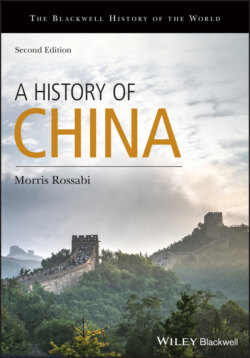Читать книгу A History of China - Morris Rossabi - Страница 38
SECULARIZATION OF ARTS
ОглавлениеDespite the political decentralization and weakness of the Western Zhou, its cultural achievements were not negligible and indeed paved the way for the efflorescence of the Eastern Zhou. Although Zhou bronzes initially resembled Shang models in technique and decoration, the weapons and ritual vessels now had inscriptions. As the number of bronze workshops increased, the vessels fashioned at these centers were no longer exclusively used for rituals. Output grew rapidly, and the more bronzes that were produced, the less well decorated and more secular they became. As a result, they were not a monopoly of the aristocracy. The Zhou decorations began to differ from those of the Shang. The shapes became less complex, and different animal forms were rarely combined to depict the legendary animals of the Shang. The vessels no longer portrayed the grotesque taotie mask, and some represented animals and particularly birds (which were now frequently depicted) in a much more naturalistic style than during the Shang.
Basic changes in decoration reveal even more clearly the transformation from Shang to Zhou thought and attitudes. These changes mirror the development in Yangshao pottery decorations from realistic portraits of animals and fish to more geometric conceptions. The animal forms in Zhou bronzes similarly turned away from realism to abstraction. At the same time, the Zhou bronzes show a greater emphasis on decorative designs. This focus on decoration may reflect a changing societal conception of the bronzes, which now had a wider and more secular audience. Instead of bronzes being produced for court rituals and awe-inspiring purposes as in the Shang, the Western Zhou bronzes were often used for ordinary occasions, eroding their evocation of majesty and their religious functions. The inscribed bronzes also indicated that the Zhou elite had them cast to commemorate significant events (victory in battle, marriage, etc.) or to communicate with the ancestors. They thus offer valuable data that supplement knowledge of the dynasty. Most inscriptions start with precise indications of the date and location, contributing to their historical value. They then describe a particular activity – a military campaign, a sacrifice, the investiture of an official, or an alliance. However, the number of divinations mentioned diminished, implying a change in attitude about direct spiritual or ancestral involvement in human affairs. Decorative objects that had little ritual significance (such as bronze mirrors and belt buckles) were often produced, and some imitated the “animal-style art” (which depicted mostly animals of prey in contorted and sometimes distorted positions) of the nomadic pastoral peoples who dealt with the Chinese.
The religious attitudes of the Western and later Eastern Zhou elite diverged from those of the Shang. Earlier beliefs centered on a variety of coequal divinities associated with nature, with Di represented as the dominant figure. The Western Zhou supplanted Di with Tian (Heaven), vital for the concept of the Mandate of Heaven, and tended to deemphasize animal and nature deities. Proper performance of ancestral rituals became at least as significant as obeisance to deities. Another indication of increasing secularism entailed transformations in the tombs. Human and animal sacrifices at burial sites diminished considerably. At these same tombs, various jade objects were buried with prominent individuals. Bi discs, symbolizing Heaven, as well as jade artifacts representing Earth and jade plugs for the openings of the deceased’s body to protect it from harm, served as important mortuary pieces. Later, in the Han dynasty, the custom of using jade to protect the body of the dead reached its height with the creation of elaborate jade suits for members of the elite. However, not all jades were designed as mortuary objects; many were fashioned as ornaments.
Despite its glorious philosophical, literary, and artistic masterpieces, the Zhou dynasty encountered difficulties in its last years. The Warring States era, with no centralized government, needed economic and political changes. Standardized currency and writing systems, regular taxes on agriculture and commerce, a local and regional administration that ensured safety and security and basic restraints on the seemingly all-powerful nobility, and a policy for dealing with occasionally obstreperous foreigners on China’s northern frontiers were required for greater stability and peace. The victory of one of the Warring States and the resulting unification and centralization of China brought about such a transformation.
